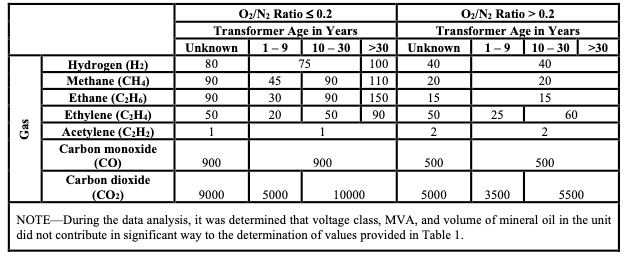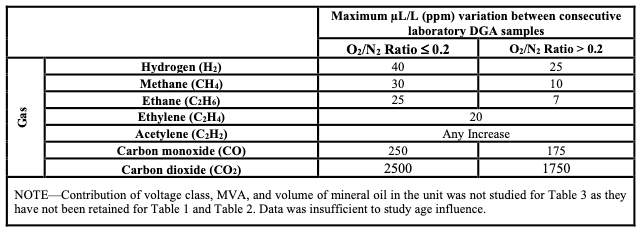Dissolved Gas Analysis Interpretation Procedure Based on IEEE C57.104-2019
- Augusto Moser

- May 31
- 5 min read
Updated: Jul 20

Introduction
Dissolved Gas Analysis (DGA) is a widely recognized diagnostic technique for assessing the health of mineral oil-immersed transformers. By analyzing gases dissolved in the insulating oil, DGA can detect abnormal conditions caused by thermal or electrical faults, enabling operators to take timely action to prevent failures. The IEEE Std C57.104-2019, IEEE Guide for the Interpretation of Gases Generated in Mineral Oil-Immersed Transformers, provides detailed guidance on interpreting DGA results. This article outlines the suggested interpretation procedure from Section 6 of the standard, offering a structured simplified approach for transformer operators and maintenance personnel.
The Dissolved Gas Analysis Interpretation Procedure
Section 6 of IEEE C57.104-2019, titled "Suggested interpretation procedures for DGA results," presents a systematic, multi-step process for evaluating transformer condition based on DGA data. The procedure is designed to ensure reliable interpretation and involves iterative steps that may require expert judgment. Below are the key steps:
1. Data Quality Review
The first step is to verify the reliability of the DGA data. This involves:
Ensuring the sample was correctly collected, handled, and analyzed according to standards like ASTM D923 and ASTM D3612.
Checking for anomalies, such as contamination or errors in sampling or laboratory analysis.
Accurate data is critical, as misleading results can lead to incorrect conclusions. If doubts arise, a confirmation sample may be necessary.
2. Compare Concentrations
Start computing the oxygen (O₂) and nitrogen (N₂) ratio to distinguish sealed units from free-breathing ones and determine which reference norms to use. Next, compare the concentrations of key fault gases—hydrogen (H₂), methane (CH₄), ethane (C₂H₆), ethylene (C₂H₄), acetylene (C₂H₂), carbon monoxide (CO), and carbon dioxide (CO₂)—to statistical norms:
Use Table 1 (90th percentile) from the standard, which is based on a large statistical study (Annex A).
This step establishes a baseline for the transformer's condition.

3. Evaluate Deltas and Rates of Change
Next, asses deltas, rate of change and compare to statistical norms:
Calculate the deltas between two consecutive laboratory DGA results (in Δ µL/L, (Δ ppm)).
Calculate the rate of increase in gas concentrations (in µL/L/year) using 3 to 6 consecutive DGA samples over 4 to 24 months.
Compare these deltas and rates to norms in Table 3 and Table 4.
A rapid or accelerating rate suggests an active fault, while stable rates may indicate a less urgent issue.
When comparing with Tables 1, 3 and 4, results in any levels above the references, compare the concentrations of key fault gases to statistical norms of Table 2 (95th percentile) from the standard, which is also based on a large statistical study (Annex A).
This step helps distinguish between ongoing fault activity and residual gas accumulation, and finally determines the severity of the case by comparing to higher gases levels references (Table 2).



Our Solutions
HV Assets has a complete solution for monitoring transformers using an advanced water, hydrogen, temperature and pressure sensor, the Basic Care Sensor, and the Early Warning Sensor, measuring hydrogen and temperature. Click here to check the technical data.
4. Determine DGA Status
After comparing the concentrations of key fault gases to statistical norms:
Classify the transformer into one of three DGA status levels:
Status 1: All gas levels below the 90th percentile (normal operation).
Status 2: At least one gas between the 90th and 95th percentiles (caution warranted, resample for confirmation and monitor possible gas evolution).
Status 3: At least one gas above the 95th percentile (potential concern, mitigative actions or
other responses should be considered).
This step flags units requiring further investigation.
5. Identify Possible Fault Types
If gas levels or rates indicate a potential issue, identify the fault type using diagnostic methods:
Primary Methods: Apply the Duval Triangle or Duval Pentagon methods (detailed in Section 6.2 and Annex D), which use ratios of the hydrocarbons to pinpoint faults such as:
Partial discharge (PD)
Thermal faults (T1, T2, T3)
Discharges of low (D1) or high energy (D2)
Supplementary Methods: Consider historical methods like Rogers Ratios or Key Gas (Annex D) for additional context.
The Duval methods, updated in this standard, provide a graphical approach to fault identification, enhancing diagnostic accuracy.
6. Assess Severity and Decide on Actions
Integrate the findings to assess the severity and determine appropriate actions:
Consider the DGA status, rate of change, fault type, and contextual factors (e.g., transformer age, load, criticality).
Possible actions include:
Normal Operation: Continue routine monitoring if no significant issues are detected.
Increased Surveillance: Shorten sampling intervals (e.g., monthly or weekly) for Status 2 or rising rates.
Further Testing: Conduct electrical, acoustic, or oil quality tests for confirmation.
Intervention: Consult experts, plan maintenance, or remove the transformer from service if severe faults (e.g., arcing) are confirmed.
The process may iterate—additional samples or tests might refine the diagnosis—emphasizing the need for trained personnel to interpret results.
Practical Considerations
Iterative Nature: The steps are not strictly linear; new data may prompt revisiting earlier steps.
Expert Judgment: Interpretation requires experience, as DGA can be indeterminate or influenced by factors like stray gassing (Section 1.3).
Supporting Tools: Annexes provide flowcharts (Annex B), fault definitions (Annex C), case studies (Annex E), and alternative severity metrics like Normalized Energy Intensity (NEI, Annex F).
Conclusion
The suggested DGA interpretation procedure in IEEE C57.104-2019 offers a robust framework for evaluating transformer health. By systematically reviewing data quality, comparing gas levels to norms, assessing trends, identifying faults, and determining actions, operators can detect and address issues effectively. While DGA is a powerful diagnostic tool, it should be used alongside other tests and operational knowledge to ensure reliable transformer performance and safety.
Our Solutions
The HV Assets Care Platform is a complete solution for data analysis and diagnostics. It includes all the recommended methods from the IEEE standard, including the Duval Triangle and the advanced Combined Duval Pentagon, integrated in an Asset Management Dashboard. In addition, provides a Health Index with individual scores to create an Asset Ranking. For more information, click here.
References
[1] "IEEE Guide for the Interpretation of Gases Generated in Mineral Oil-Immersed Transformers," in IEEE Std C57.104-2019 (Revision of IEEE Std C57.104-2008) , vol., no., pp.1-98, 1 Nov. 2019, doi: 10.1109/IEEESTD.2019.8890040.





